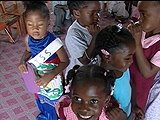This is fabulous:
New Preschool to Teach Only in Spanish
By MELISSA SÁNCHEZ
STAR-TELEGRAM STAFF WRITER
Five years ago, Plano teacher Vicki Kelly wasn’t bilingual, but she wished her children were. And she wasn’t alone.
Kelly and two other mothers, one from Peru and one from Mexico, decided to teach preschool to five children — in Spanish.
“The Hispanic population is growing every year, and families who speak only English have no way to give their kids the Spanish language,” Kelly said.
Through word-of-mouth, the news spread to other mothers and by the end of the year, the tiny class that started in Kelly’s living room grew to 80 children, she said.
The class moved to a church classroom and later filled four. Two years later, the trio of mothers started the Spanish Schoolhouse in Frisco. In August, the program will expand to Grapevine and North Dallas.
The preschool offers cultural programs designed to teach and develop preschool skills speaking only Spanish.
The school is part of a trend toward a bilingual population, spokeswoman Tami Shinedling said.
Children enter the Spanish Schoolhouse preschool at age 2 and are immersed in the Spanish language and culture during the school day until they move to kindergarten.
At the beginning of the school year, both English and Spanish are spoken so pupils can understand the rules and expectations and get to know their teacher. A smooth transition to Spanish-only is easy and even fun for them, Kelly said.
Teachers act out what they are saying so that children will understand. If the teacher ever doubts the children understand something, she briefly explains in English and then continues in Spanish. Students also have a daily English class to help develop reading skills and prepare them for kindergarten in regular school.
“We are here to encourage the love of the Spanish language and will ensure that the children feel comfortable and secure in the environment of our school,” Kelly said.
Research shows that the best time to learn additional languages is from birth to age 12 or 13, Kelly said. Spanish Schoolhouse takes advantage of that “window of opportunity.”
She said the school’s teachers are native Spanish speakers.-
Sarah Salzer is a fan of the school. Her 6-year-old daughter, Peyton, has attended Spanish Schoolhouse since it opened three years ago, and now corrects her mother’s pronunciation of the word mango.
Spanish Schoolhouse “has made her more accepting of other cultures,” Salzer said. “I don’t agree with the opinion that because we live in the U.S. we should only speak English. In Aruba, people speak five languages, and if we don’t start soon we’ll miss the boat.”- IN THE KNOW Spanish Schoolhouse













